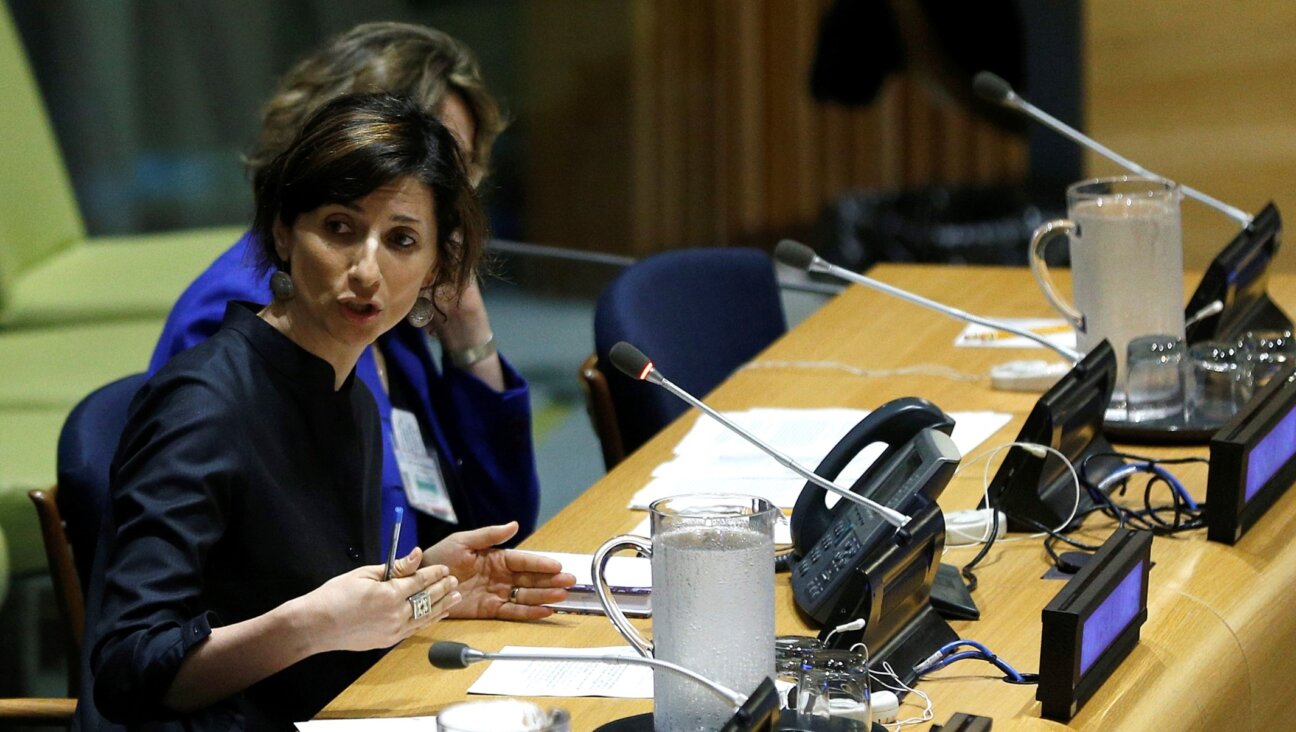Company Director Answers Senate Regarding the Titanic
This article was published in the Yiddish-language Forward on April 20, 1912.
Yesterday, the U.S. Senate committee that was directed to investigate circumstances and facts regarding the major accident that occurred to passengers of the Titanic heard several witnesses.
The first witness to be called was Bruce Ismay, managing director of the White Star Line, the ship company that owned the Titanic.
The session of the investigative committee took place at the Waldorf Astoria Hotel in New York. The committee chair, Senator [William Alden] Smith of Michigan, swore in Mr. Ismay, who haltingly repeated the oath, his head lowered as he gazed at the floor. After the oath was administered, the witness responded to questions regarding his name, occupation, residence and professional activities, etc. The chair then questioned him as to whether he had traveled with the Titanic as director of the company.
He responded that he had traveled voluntarily as a regular passenger. Afterward, the chair requested that he tell him everything about the journey. Mr. Ismay began by assuring the committee that he hadn’t much to add but would tell all that he knew. “We left Cherbourg,” he recounted, “Wednesday, April 10, at 8 p.m. The first day, the steamer traveled 464 miles, the second day 519 miles and the third day 564 miles.”
“Where were you when the accident occurred?” asked the chair.
“I was sleeping at the time and I don’t know the details of what occurred prior to the accident.”
When asked if the steamer was traveling at full speed, Mr. Ismay answered that it wasn’t and that the steamer could have gone much faster.
The chair asked: “Had you given any orders to the ship’s captain? Had you ordered the steamer to go faster or slower?”
“No, I gave no orders,” Mr. Ismay said. “I did not get involved at all. I merely decided with the captain that the steamer should arrive in New York no earlier than Wednesday at 5 p.m.”
“Did you know that you were not far from icebergs?”
“Yeah, I heard about them.”
“Had you previously traveled the northern route?”
“No, I typically traveled via the southern route.”
“Did you know that the America had warned you about the icebergs?”
“No.”
“How many sailors were in each lifeboat that was lowered?”
“I don’t know.”
“Were all the women and children rescued?”
“I don’t know for certain.”
“Which women were taken earliest into the lifeboats?”
“Women were taken indiscriminately out of the crowd with no regard for their class.”
“Did you not perhaps notice that there were fewer sailors in some lifeboats?”
“No”
“Did you not hear that on the second lifeboat there weren’t enough sailors and that the women had to row themselves for six to seven hours?”
“I hadn’t heard that.”
“How did it happen that you sat in one of those lifeboats?”
“It was the last lifeboat lowered. There were no more women aboard and so I jumped in.”
“Were there enough rescue options aboard the Titanic?”
“Yes…”
“Tell us something about the ship’s sinking.”
“I didn’t see it. On my lifeboat, we had traveled a distance away and separated from the Titanic.”
“Was there an explosion on the ship?”
“No.”
“Did you see the captain before you sat in the lifeboat?”
“No.”
“Did you take a message with you from the captain?”
Mr. Ismay thought for a long time, seeming to struggle over his answer. Finally, he responded that he had taken no message. Senator [Francis] Newlands of Nevada asked about the speed of the ship. Mr. Ismay answered that the steamer had traveled with a speed of 21 knots — 26 miles per hour.
“Did you have rafts aboard the steamer?” asked the chair.
“Mr. Ismay once again sank deep into thought before responding. He looked at his nails, at the ceiling and at the floor. Finally, he answered that no, there were no rafts aboard the Titanic, because the company thought that this type of steamer was less likely to need special rescue supplies.
The members of the committee then posed various questions about the ship’s structure. To all of those queries, Mr. Ismay answered that he didn’t know and he didn’t recall.
“When did you eat dinner?” asked the chair.
“Half past 7,” Mr. Ismay responded.
“Did Capt. Smith eat dinner with you?”
“No.”
“You don’t know whether anyone was killed when the ship split up?”
“I don’t know…”
Senator Smith then leaned forward in his chair and looked at Mr. Ismay for a long time, as if trying to penetrate him with his gaze. Finally, he posed a question that drew attention. The room became silent, with everyone straining to listen to Mr. Ismay’s response.
“Mr. Ismay…” The chair spoke slowly and calmly. ”Were all the women and children saved?”
Mr. Ismay lowered his head and answered so quietly it was difficult to hear him.
“Not all were rescued,” he murmured.
“How many of the women and children were saved?”
“I don’t know.”
“Mr. Ismay,” the chair asked again, “when you were already on the Carpathia, did you send a telegram to anyone?” “No,” answered Mr. Ismay, who seemed upset.
The chair told Mr. Ismay that he would be called a second time. And then Capt. [Arthur Henry] Rostron of the Carpathia took the witness stand.
Capt. Rostron recounted that just before daybreak on Monday, at 12:35 a.m., it was announced that a steamer had crashed into an iceberg, and that it was the Titanic and it was in danger.
“At that point,” Capt. Rostron said, “I gave orders to travel close to the location where the Titanic was to be found. At the same time, I ordered the staff to prepare everything necessary to rescue a large number of people: lifeboats, life belts, medicine, food, beds, stretchers, etc.
“The Carpathia was about 60 miles away from the Titanic. We covered that distance in two and a half hours. At four o’clock, I ordered the engines to be shut down. I recall we had arrived at the site of the Titanic’s accident.
“I wasn’t wrong about that, because as soon as I had the steamer stop there, I heard sounds from a lifeboat. Icebergs and ice floes were floating all around. I tried to guide the ship around the ice and to get close to the lifeboat.
“The lifeboat eventually had to get over to us, but couldn’t because there was only one sailor in that lifeboat and an officer from the Titanic. These two had been rowing that lifeboat for more than several hours and they were exhausted.
“Dawn was breaking, and I saw other lifeboats in various places between icebergs and floes.
“By half past eight, everyone in the lifeboats was aboard the Carpathia. That’s when I realized that the Carpathia was exactly on the spot where the Titanic had sunk, which was why the water there was covered with all kinds of detritus, and one could see things floating there that could only have come from a steamer.
“On one side of us, the Californian was sailing not far off. I immediately sent him word of the sad news about the Titanic and requested that he search everywhere in case they came up against floating corpses or living survivors.
“A priest on the Carpathia prepared a service. I ordered him to do that in order to encourage the survivors. As the priest conducted the religious ceremony, I traveled around the site of the accident. We found only one corpse, that of a sailor with a life belt around him.
“That was the only dead body we pulled from the water. Aside from that one, we found three corpses in the lifeboats. Those were passengers who had frozen to death or who had died from fear or hunger. We ‘buried’ those bodies at 4 p.m.
“All of the rescued, especially the women, were in good condition and were no trouble for us.”
Senator Smith asked: “How many lifeboats were there?”
“There were 18 lifeboats in the beginning,” Rostron said. “One of those was overturned, and the people drowned in the water.” “How much time did you spend at that site?”
“Half an hour.”
“What was the last telegram from the Titanic?”
“The last telegram said: ‘The engine room will be flooded shortly.’”
“At what time was that?”
“That was at 25 minutes after one.”
“What did you answer to that?”
“I responded, confirming that we were already on our way, and that we hoped that it wouldn’t take us more than four hours to get there.”
Capt. Rostron further recounted that the Carpathia had traveled very quickly, at a speed of 24 miles per hour, as she hurried to the spot where people were struggling against death.
When the chair drew his attention to the fact that any form of speeding was inherently dangerous, the captain responded that at the time he wasn’t concerned with risk. He was only focused on arriving at the accident site as fast as possible in order to save lives.
In answer to the question about whether women had been forced to row the lifeboats, Rostron stated that on two to three lifeboats, there weren’t enough sailors and so the rescued women themselves had to take the oars.
Capt. Rostron’s responses made a good impression and the committee thanked him for his service.






















